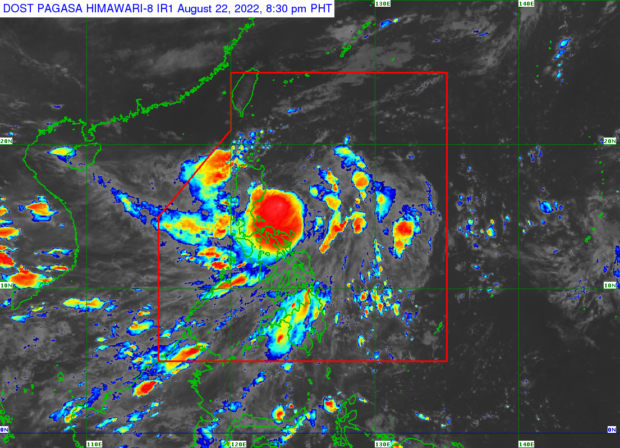
Source: DOST / Pagasa
LEGAZPI CITY, Albay, Philippines — Heavy rainfall spawned by Tropical Storm Florita on Monday triggered landslides and flooding, and prompted the suspension of classes in several localities in Albay and Cagayan Valley provinces just as schools resumed in-person sessions after being shuttered by COVID-19 two years ago.
But in most parts of Luzon, the Visayas, and Mindanao, in-person classes proceeded amid the usual problems bugging the opening of the school year: traffic jams in routes leading to schools and the shortage of facilities like classrooms and chairs in many public schools.
In Albay, Gov. Noel Rosal has ordered a suspension of classes at all levels in both public and private schools.
Two elementary schools in Polangui town were also flooded following the torrential rains, forcing the class suspension, added Mayor Adrian Salceda.
Elsewhere in Albay, floods submerged the village of San Isidro in Libon town and portions of the villages of Ilawod, Tagaytay, Bariw, and Libod in Camalig town.
In Cagayan province, classes at all levels were suspended in Tuguegarao City and the towns of Solana, Lal-lo, Enrile, Ballesteros and Aparri on Monday.
Gov. Manuel Mamba also imposed a liquor ban and a “no sailing, no fishing” policy, with Florita expected to hit the province by Tuesday.
Local authorities were also preparing for the possible rise in the level of several rivers in Cagayan, warning residents in low-lying areas to brace for flooding.
In Isabela province, classes were also suspended in the towns of Tumauini and Cabagan while Ilagan City only allowed classes in the college level.
In Ilocos Norte province, afternoon classes from preschool to elementary were suspended in the capital city of Laoag and in the towns of Solsona, San Nicolas, Paoay, and Vintar.
Storm signals
Florita was located 215 kilometers east of Casiguran town, Aurora province, as of 11 a.m. on Monday, packing a maximum sustained winds of 75 km per hour (kph) near the center and gustiness of up to 90 kph, according to the Philippine Atmospheric, Geophysical and Astronomical Services Administration.
As of 11 a.m., Tropical Cyclone Wind Signal (TCWS) No. 2 was hoisted over the eastern portion of Cagayan province, the eastern and central portions of Isabela province, the extreme northern portion of Aurora province and the northeastern portion of Quirino province.
The rest of Cagayan, Isabela and Quirino were placed under TCWS No. 1, along with the provinces of Nueva Vizcaya, Apayao, Abra, Kalinga, Mountain Province, Ifugao, Benguet, La Union, Ilocos Norte, Ilocos Sur, northern and central portions of Aurora, and northern portion of Polillo Island.
Safety ensured
In earthquake-ravaged Abra, schools welcomed back their students on Monday but some students had to temporarily spend the day in makeshift learning spaces because of their damaged classrooms.
In Abra’s capital town of Bangued, makeshift classrooms that were separated by walls made of bamboo and tarpaulin sheets were set up at a covered court for the 92 students of Macarcarmay Elementary School.
According to the Office of Civil Defense, 233 Abra classrooms were destroyed by the quake last month.
In the northernmost town of Itbayat in Batanes province, 151 students from Itbayat Central School held their classes in makeshift classrooms at the Alternative Learning Systems building in the town’s plaza. Their school is still undergoing repairs after it was hit by a magnitude 6 earthquake in 2019.
In Oriental Mindoro province, 178 students of Tugdaan Mangyan school at Naujan town began the school year with a planting ritual at the foot of Mt. Halcon.
In Calabarzon region, Department of Education (DepEd) officials welcomed 3,899,077 students during the school opening in public and private schools, with policemen deployed to schools to provide security and maintain peace and order, said DepEd Regional Director Alberto Escobarte.
Anti-dengue measures
Local health workers also installed “Olyset nets” in the school windows to protect the children from the bites of infected Aedes aegypti mosquitoes that spread dengue viruses.
Anti-dengue measures were also put in schools in Cebu City and Negros Occidental and misting machines were used prior to class opening to destroy breeding grounds of dengue mosquitoes.
Dr. Jeffrey Ibones, head of the Cebu City Health Department (CCHD), said the city’s dengue team would educate students on how to prevent dengue and other water-borne diseases. The CCHD has reported close to 2,000 dengue cases, including 19 deaths, in the city from January to August 2022.
For the rest of the Visayas, the opening day went smoothly despite the perennial problem of lack of classrooms and other facilities.
—WITH REPORTS FROM MA. APRIL MIER-MANJARES, MICHAEL JAUCIAN, VILLAMOR VISAYA JR., JOHN MICHAEL MUGAS, VINCENT CABREZA, VALERIE DAMIAN, YOLANDA SOTELO, NATHAN ALCANTARA, DELFIN MALLARI JR., MADONNA VIROLA, LEO UDTOHAN, CARLA P. GOMEZ and ADOR VINCENT MAYOL
RELATED STORIES
Signal No. 3 raised as ‘Florita’ intensifies into a severe tropical storm
101 classes suspended Tuesday due to Florita